Much Loved Brand Kras Creates Chocolate with Croatian Cvarci
April the 30th, 2022 - It might sound like a very late April Fool's joke, and it in fact began its ''life'' as such, but the much loved Croatian chocolate brand, Kras, has seriously created a chocolate bar with Croatian cvarci (pork scratchings) inside it. Here's where you can purchase it.
As Poslovni Dnevnik writes, it all started out as an April Fool's joke from the company on social media, but Kras recently announced on its official Facebook profile that they really have created a bar of much loved Dorina chocolate, but with Croatian cvarci inside it.
They first mentioned this combination in terms of an April Fool’s joke, but, as they explained for N1, the interest from people who saw the joke was so great, and the questions about the chocolate bar so frequent, that they really decided to make a Croatian cvarci infused chocolate bar.
Anyone who wants to try this chocolate for themselves, or just wants to buy it to keep on the shelf as a bit of a joke, can do so as of today as Kras choco and cafe. You may have to get your skates on, however, as this weird and wonderful chocolate bar is a limited edition and when stocks are gone, they're gone.
For more, make sure to check out Made in Croatia.
Excellent Pre-Season Results for Croatian Arena Hospitality Group
April the 30th, 2022 - The Easter weekend of 2022 brought with it some excellent results for the pre-season and with it high hopes for the height of this year's summer tourist season. The Croatian Arena Hospitality Group has done very well indeed.
As Poslovni Dnevnik writes, for the Croatian Arena Hospitality Group, the recent Easter weekend met all of their expectations and about 15,000 overnight stays were realised. The largest share of that number was made up of guests from Germany, Austria and neighbouring Slovenia, but there was also a pronounced increase in domestic guests. Guests come mostly in their own individual arrangements, while a third arrived with organised groups. The result for the Easter weekend of 2022 is many times higher than last year and is a great introduction to the season after the past two pandemic-dominated years.
Before Easter, the hotels Park Plaza Histria in Pula and Park Plaza Belvedere in Medulin were opened. The Park Plaza Verudela settlement in Pula has also now been opened, and the Arena Grand Kazela camp in Medulin is open all year round, so that guests can enjoy 365 days a year in rest and relaxation. The Arena Holiday Hotel in Medulin and the Arena Stoja, Arena Medulin and Arena Stupice camps were also open for Easter.
"Thanks to our experience of over 40 years in the hotel and catering/hospitality industry, we know that guest satisfaction is a priority. The primary goal of the Croatian Arena Hospitality Group's facilities is to provide superior service to our guests in an authentic natural environment. The most important event of this season is the opening of the Grand Hotel Brioni in early May. We can't wait to present this new hotel, a unique experience, an excellent gastronomic offer and beautiful views of the sea and the Brijuni islands,'' said Manuela Kraljevic of the company.
In its portfolio, the Croatian Arena Hospitality Group has its own brands Arena Hotels & Apartments and Arena Campsites. As part of the prestigious Park Plaza Hotel Group Limited, it runs and develops the international hotel brands Park Plaza and art’otel facilities across 18 Central and Eastern European countries. The company is opening the first art’otel hotel right here in Croatia at the end of this year in the City of Zagreb, and it will boast 118 rooms under the name art’otel Zagreb.
Guests can visit a total of 29 facilities with more than 10,000 accommodation units in Istria, soon in Zagreb, Nassfeld in Austria and in major cities in Germany and Central and Eastern Europe - Belgrade, Berlin, Cologne, Nuremberg and Budapest.
At the peak of the season, the Croatian Arena Hospitality Group has over 1,800 employees, and the entire group has 700 full-time employees throughout the year. With the expansion of business, the need for the constant employment of quality staff is growing, as is the need to expand the company's team of seasonal workers. A professional work environment, stimulating conditions, a positive atmosphere and the loyalty of employees are the result of this company investing in human resources.
"Here in Croatia, the Arena Hospitality Group is present with more than 8,500 accommodation units through a diverse range of accommodation facilities, from hotels and resorts to campsites located in the most prominent tourist regions of Croatia, Istria, and Zagreb is now under development. We host 340,000 guests a year in Croatia, and the top service we provide wouldn't be possible without the best team of people behind our success,'' said Manuela Kraljevic.
For more, check out our business section.
Great Demand for Inland Dalmatia Tourism, Says Split-Dalmatia County Tourist Board
April 30, 2022 - Inland Dalmatia tourism is a hit, says Split-Dalmatia County Tourist Board director Joško Stella.
Split-Dalmatia County Tourist Board director, Joško Stella, is running for a new term at the helm of the tourist board. After presenting the Tourism 3.0 project, Dalmatinski Portal spoke to Stella about the results of his work, expectations from this season, and trends in tourism.
Which parts of Split-Dalmatia County have made the biggest step since you became the head of the Tourist Board?
"Split Riviera and Makarska Riviera make the largest traffic as clusters in Split-Dalmatia County, and we also know that the city of Split has made a big step forward in tourism in the last five years. As for Inland Dalmatia, I would especially like to point out the area of Imotski where a large number of villas with swimming pools were built."
Many villas with swimming pools have been built in Inland Dalmatia in recent years. But is the demand still growing?
"There is a great demand for Inland Dalmatia and villas with swimming pools located in the hinterland, coast, and islands."
Did the pandemic affect the number of apartments in Split?
"The number of apartments in Split has decreased."
The world is changing fast, and so is tourism. What is the current trend that the general public may not be aware of?
"The current trend in the world is a return to nature, outdoor activities, exercise, walking, cycling, and general recreational sports. However, I would add that the growing trend is healthy food and quality nutrition where our Mediterranean cuisine has a great chance to grow as a brand."
The tourist board has been pushing cycling tourism in the county. What are the results?
"We have been systematically developing cycling tourism in the county since 2013. The result is over 3000 km of trails, over 200 'bed and bike' apartments, 50 bike hotels, and ten bike camps. In addition, the result is an increasing number of smaller and larger bicycle races and a growing number of organized groups of cyclists coming to our county."
Will this season break the 2019 record?
"From the beginning of the year to April 27, we have 2.8 times more overnight stays than last year, and if we compare with the same period in 2019, we are at 88 percent of overnight stays from pre-pandemic, record, 2019. So we are certainly expecting a better year than 2021, and we are expecting figures close to 2019, Of course, unless there are some unforeseen circumstances."
The City of Vienna recently launched a €2 million financial incentive program for film and television productions called 'Vienna Film Incentive.' The program should contribute to the growth of the economy and tourism and increase the attractiveness of Vienna as a tourist destination, and is expected to last until the end of 2023. The filming of Game of Thrones has contributed to popularizing Dalmatia. What can be done institutionally to make this industry more regularly choose our area?
"Split-Dalmatia County and the Split-Dalmatia County Tourist Board are actively working to establish a film office that would promote film tourism and locations in the destination for future filming. Back in 2015, we released a map of locations for Game of Thrones in several languages and presented it at the Barcelona fair, where we co-financed a copy of the original throne from the film. In the following years, we actively brought in journalists related to the filming of Mama Mia and Game of Thrones."
The season is already visible and is slightly longer, lasting more than two months. So what else can be done?
"7-8 years ago, it started at the end of April, and now at the end of March. The flights ended in early October and now end later that month. With the development of particular forms of tourism such as enogastronomy, cultural and active tourism, we are already extending the tourist season. It is a process that has been going on for years, but progress is already visible."
The arrival of guests is related to the number of flights and the price. What can be done to increase the number of flights and make them more affordable?
"In 2022, in cooperation with the CNTB and the Split Tourist Board, we co-financed eight airlines. We agree with Croatia Airlines for additional routes in the winter flight schedule and are negotiating additional routes and flights."
The tourist board does a lot of education throughout the county. What are the reactions?
"In 2022 alone, we already had 15 trainings for private renters and four trainings for agencies where I would like to point out that we brought Rob Holmes from the USA and Victoria Smith from the UK. There are currently five trainings for EU funds in tourism. Attendance at most trainings is excellent. I would also like to point out that we have co-financed nine trainings for our local tourist boards.
Since 2012, we have been the first in Croatia with organized free trainings for private renters, and we are known to have the most free trainings of all county tourist boards in Croatia. The result of all this is that over 8,000 people and over a thousand more from the entire sector went directly through our trainings for private renters, thus raising the level of knowledge and competitiveness of tourism in our county."
What else makes the Split-Dalmatia County Tourist Board stand out?
"We, as the County Tourist Board, are leaders in the field of education and cooperation with private landlords (education, conferences, web pages, co-financing the Apartment Plus magazine, and cooperating with Landlord Counseling). In addition, we have exceptional cooperation with agencies in our area (DMK competition, cooperation with UHPA / education). We also highlight projects: 1. Marketing through social networks (Facebook and YouTube), 2. Development of cycling tourism (trail design, promotional materials, fairs, and races), 3. Development of themed hiking trails (the only tourist base in Croatia if not in Europe that has Google StreetView for all themed trails, special website, and printed materials), 4. Sustainable development and strategic planning, The only tourist board with a Capacity Study, 5. The first tourist board in Croatia to implement the Economic effects of tourism, 6. Cooperation with local tourist boards (joint advertising, special calls for tenders, co-financing trainings, and arranging destinations)."
For more on travel in Croatia, follow TCN's dedicated page.
Dragovoljac Officially Drops Out of Croatian First League
April 30, 2022 - Hrvatski Dragovoljac has officially dropped out of the Croatian First League.
With Friday's 2:1 defeat to Hajduk, they remained at 18 points, nine less than Istra 1961, which is in second-to-last place. It is important to note that the head-to-head ratio is the second criterion for ranking in the event two teams have the same number of points.
In the previous four meetings, Istria defeated Dragovoljac three times and drew once. In the first game, Istra won 3:1, in the second 1:0, and in the third 3:0. The fourth meeting finished 0:0. In the end, the influx of players from Rijeka did not help Dragovoljac.
After entering the First HNL this season, they will leave Croatia's top league after 36 rounds.
Recall that in the first round of licensing for the next football season, the Croatian Football Federation's Club Licensing Department did not give Dragovoljac a license for the First or Second HNL.
Varaždin and Rudeš are fighting to enter the highest rank of Croatian football.
Rudeš is currently five points behind Varaždin in first place The two teams meet today in Varaždin, which has gained serious interest among fans of both teams.
After NK Varaždin invited all fans to visit Zagreb for Saturday's match, the interest in the derby against Rudeš became higher than planned.
"Dear friends of the club, due to a large number of inquiries regarding tickets for Saturday's match against NK Rudeš in Zagreb, we inform you that the club received information today that the host will sell tickets and the club took over some of them on Friday afternoon. Rudeš received more tickets than the percentage described in the HNS propositions, but the number cannot cover the interest due to the capacity of the Rudeš stadium. The club still has a part of the tickets for friends that are intended for visiting fans, so we ask those who are interested to contact us directly. Due to the situation - please contact us only if you are sure of your arrival because they will be available in the parking lot of the stadium after confirmation in your inbox. Also - we hope that tickets for the grandstand will be available at the stadium, but we do not have official confirmation or information. If we have more information - we will inform the public through this channel of communication. Thank you for your understanding and support!" reads the official Facebook page of NK Varaždin.
Rudeš still must face Osijek II, Jarun, Sesvete, and Dugopolje before the end of the Second HNL season. Varaždin must face Jarun, Sesvete, Dugopolje, and Dubrava Zagreb.
To read more about sports in Croatia, follow TCN’s dedicated page.
Croatian Skier and 3x Olympian Andrea Komšić Ends Career at 25
April 30, 2022 - Croatian skier Andrea Komšić has decided to end her professional skiing career at the age of 25.
Andrea Komšić was a promising skier and even at the Olympic Games three times, in 2014, 2018, and 2022, reports 24Sata.
The Zagreb native who was born in Kiseljak (BiH) studied in America and was a university champion while studying international relations and marketing in Denver. Unfortunately, Andrea has struggled with serious injuries throughout her career that seem to have influenced her decision to stop skiing professionally.
Two years ago, she was the 45th slalom skier in the world, but due to financial reasons, she was not included as a full member of the Croatia national team.
The last two seasons were mostly marked by severe injuries, especially two months before the start of the 2021/2022 season when she broke her foot. After that, she contracted the coronavirus and did not manage to get back into competitive form.
In addition, Andrea suffered from back problems and could not finish the race at the Beijing Olympics.
"Luck did not anoint me healthily. Until the day of the race, everything was fine, I had self-confidence, but before the race my back stiffened, they had to help me down the track. We tried pills but to no avail. The next day we had a break and a chance to fix up for the slalom, but even that wasn't enough. There were tears in the warm-up, but I said I would start at any cost. And I started and I know I was missing a couple of turns but it didn't work out," Komšić said about what happened in Beijing.
Father Davor, a ski coach and president of the Nordis club in Split, led the careers of Andrea and her brother Dario.
"My dad has always been my coach. I don’t know if I could imagine anyone else in that place. There is nothing he would not do for me. Without him, I certainly would not have been able to reach the World Cup," said Andrea at the age of 16.
Andrea had her first start in the FIS race at the age of 15 in Rovaniemi, Finland in 2012. She started 30 times in the World Cup and never managed to win points.
Apart from Beijing, she represented Croatia at the Sochi Games in 2014, where she was 33rd in slalom and 35th in giant slalom, and four years later in Pyeongchang, she took 31st place in slalom and 32nd in giant slalom.
To read more about sports in Croatia, follow TCN’s dedicated page.
48 Hours in Osijek: Slavonian Pot of Content
30th of April 2022 - Green City, Lega City, Bike City, a City on Drava River... Osijek has earned a lot of names through the years and today is one of the most contemporary places in Croatia. A look into how you can spend 48 hours in Osijek.
In recent years, TCN wrote on multiple occasions about how the city of Osijek has every characteristic of a modern European town - culture, history, recreation, developed IT sector, student city with a lot of youth, enormous potential, and so on. Furthermore, the tourist offer became so diverse in the last few years that Osijek became a city for everyone.
For this list, we decided to split time frames into two sections: day one, which would be reserved for relaxing exploration of the city, and day two, for more recreational and exciting options. Now, without further ado, let’s start our 48 hours in Osijek guide!
9.00 a.m - 10.30 a.m
Every good day needs to start with a good breakfast and what is better than Restaurant Waldinger’s cuisine? Very few. Cozy ambient, calm atmosphere, great food, and the beautiful Osijek Co-cathedral of St Peter and St Paul just down the street with breakfast that stems from Slavonian and traditional to modern and worldly. For day one, we definitely suggest Waldinger.
Day two can start with something stronger - food on a stick. Fast food and street food restaurant Hokus Pokus is located just down the street from the previous selection and serves everything from breakfast to dinner. Meaty products aren’t the only food available - veggie options are also proudly displayed in this urban restaurant. Tortillas, kebabs, ćevapčići, and tasty salads are truly a good start for an active day in Osijek.
11.00 a.m. - 1.00 p.m.
Day one can be spent in various ways - just stroll through the city on foot and visit numerous green parks like King Petar Krešimir the Fourth Park that’s surrounded on all four sides by beautiful maple trees and King Tomislav Park which connects European Avenue and Tvrđa with its beautiful row of poplars. Since you’re already there, why not use that opportunity and visit, already mentioned, the old town of Osijek, Tvrđa. It’s the best-preserved ensemble of Baroque buildings in Croatia and has a Habsburg star fort built on the right bank of River Drava. Tvrđa also has a culturally rich Museum of Slavonia, that consists of art and heritage stemming from baroque to recent creations.

Tvrđa (photo credit: Mario Romulić)
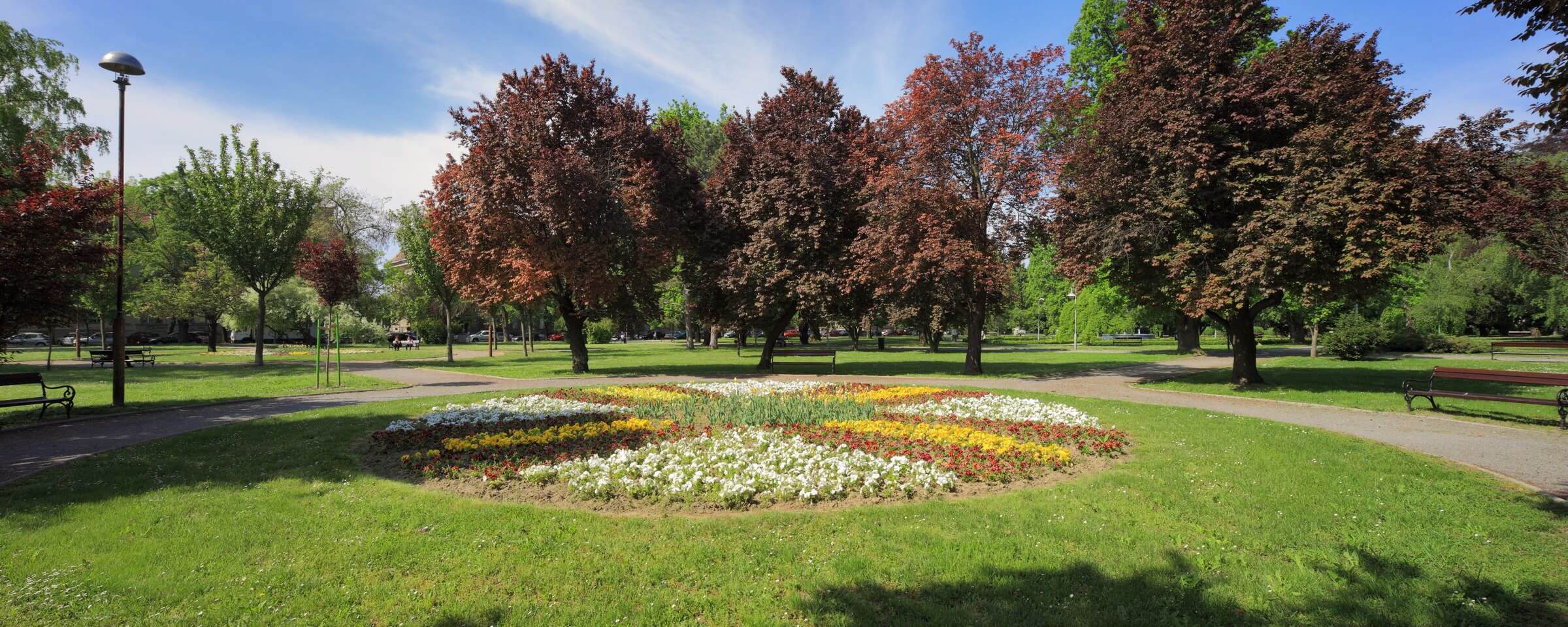
King Petar Krešimir The Fourth Park (photo credit: Mario Romulić)
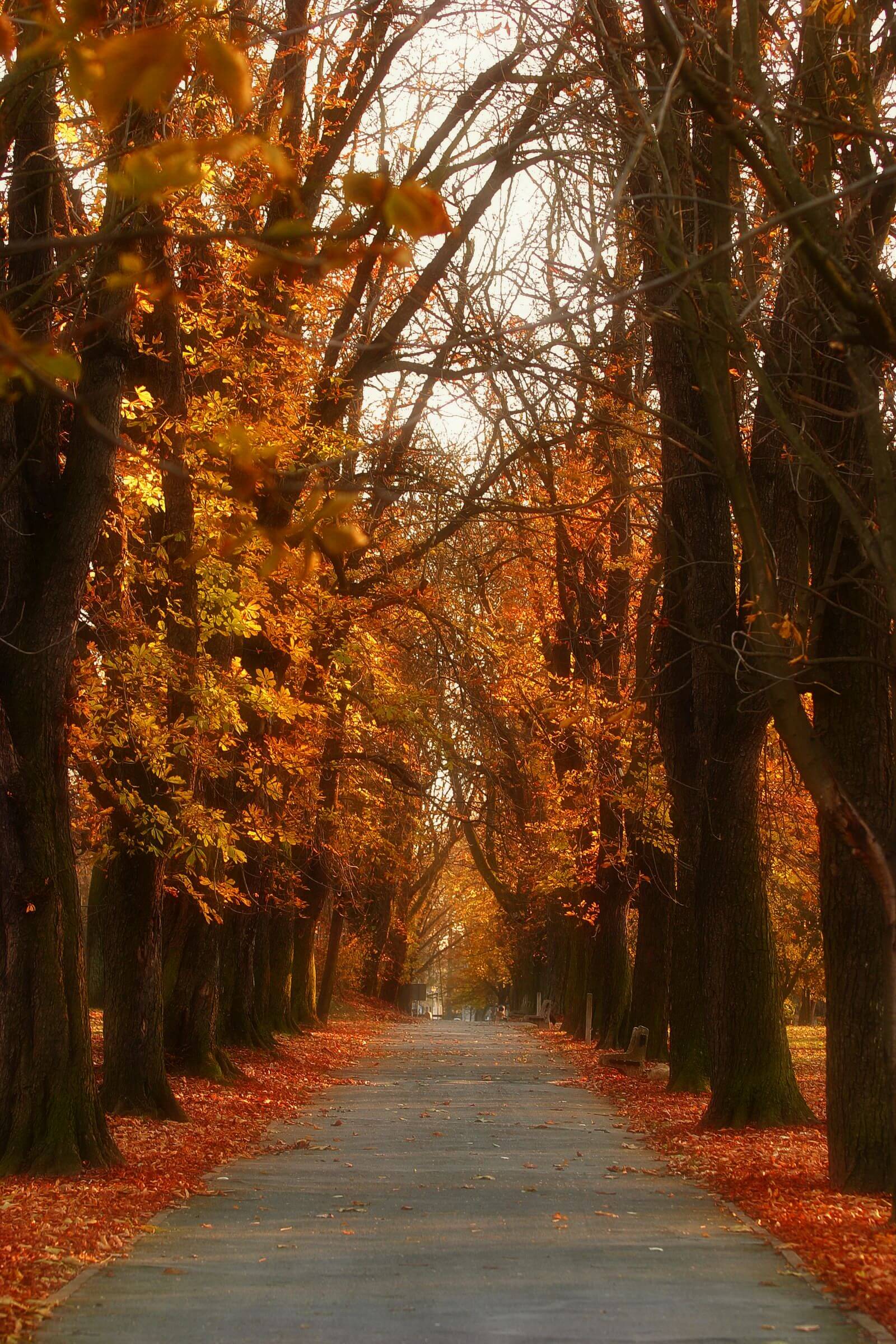
King Tomislav Park (photo credit: Mario Romulić)
After Tvrđa, use that time to sit down and have a cup of coffee - an obligation that’s never skipped in Croatia with the view of the Museum of Slavonia, faculties, schools, and old Churches of Saint Michael and Holy Cross.
The recreationally active day two can be used for biking through the city - Osijek has one of the most developed bike tracks in Croatia so if you’re even a little bit interested in being active while on holiday, biking through Osijek is a must.
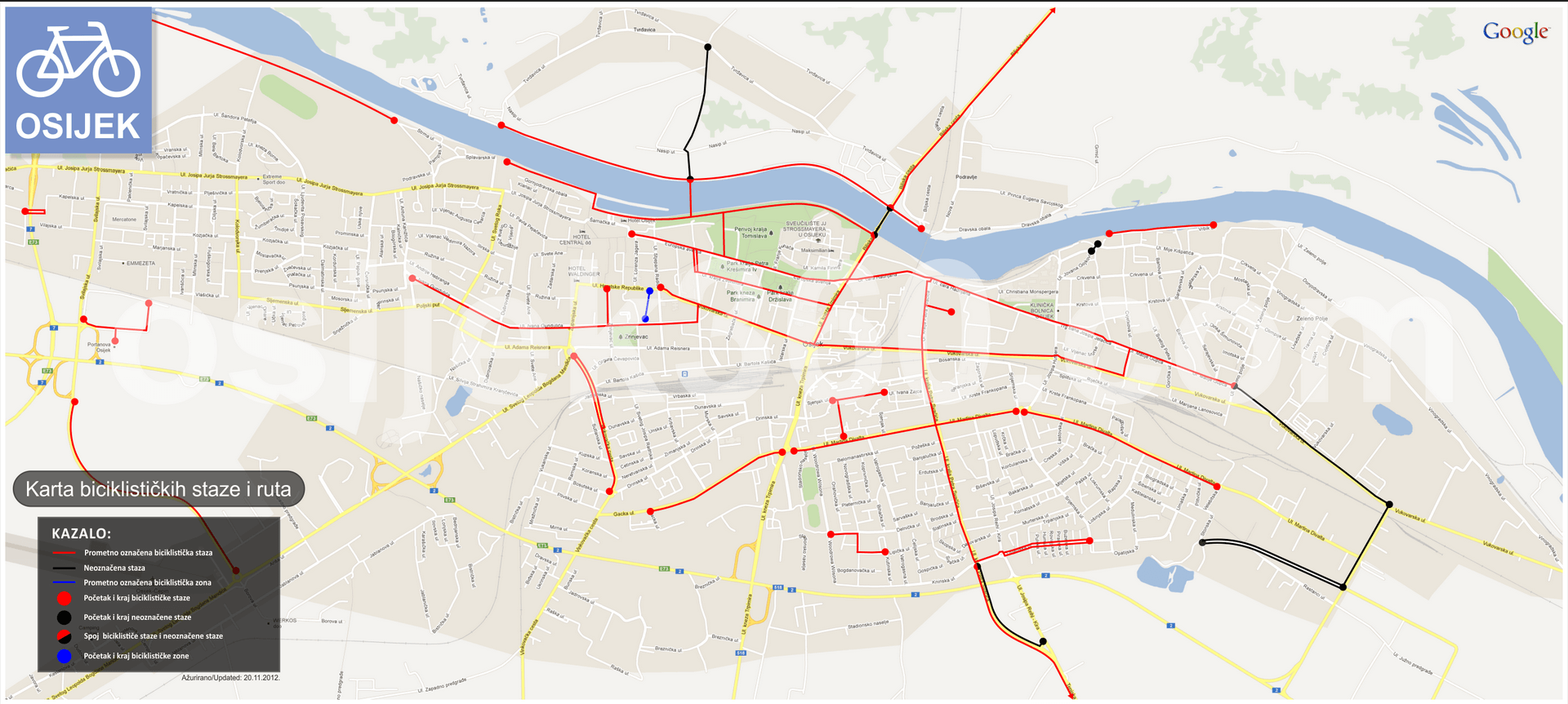
City bike routes (screenshot: www.osijek360.com)
While you're biking, cross River Drava over the popular "Bridge of youth", now symbols of Osijek, or take "kompa" and go to Osijek ZOO. "Kompa" is one of the symbols of Osijek as well - a means of transport powered only by Drava River currents transporting residents of Osijek since 1916. There's another option: take both! You can transport your bikes on "kompa" as well.
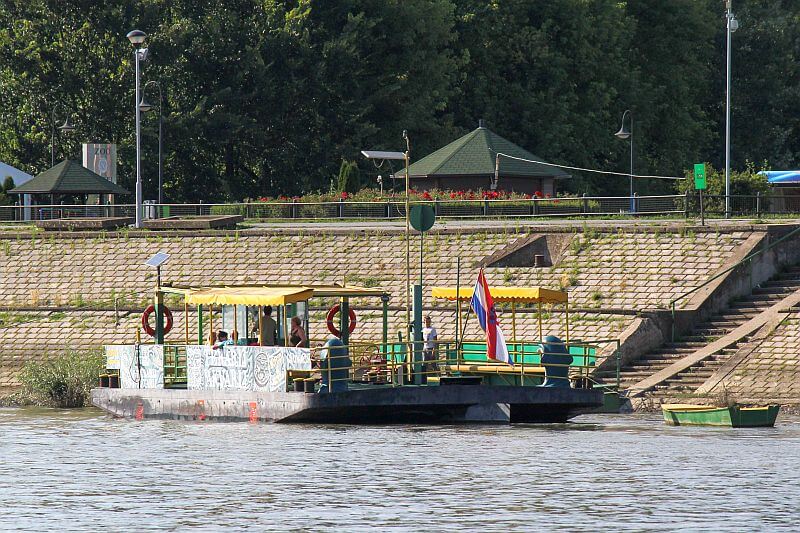
Popular "kompa", faithful "carrier" of Osijek residents since 1916 (photo credit: www.tzosijek.hr)
Osijek ZOO has been founded in 1955 and thanks to the location away from the city noise, it’s the perfect place for the peaceful stay of 80 species of animals. Next to the ZOO, there’s a hotel and catering facility with a children’s playground and a view of River Drava. All of that is near the beautiful Podravina forest.
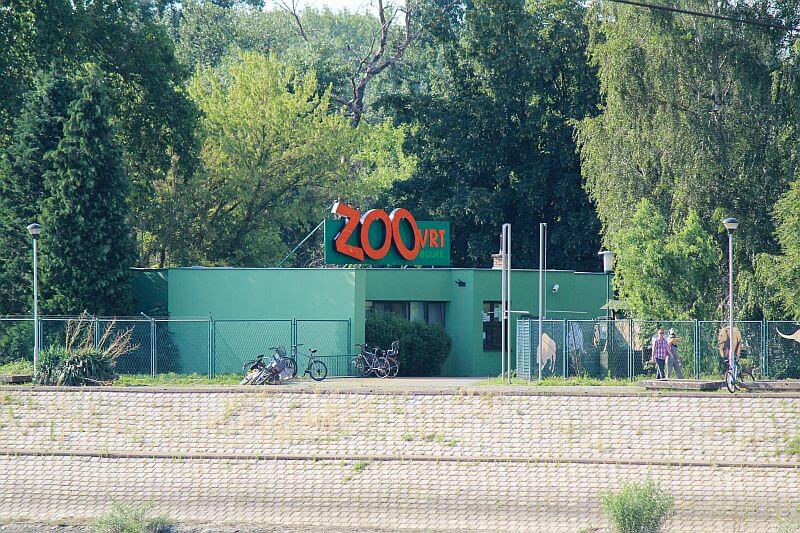
Osijek ZOO (photo credit: www.tzosijek.hr)
2.00 p.m. - 4.00 p.m.
After some sightseeing, day one should surely feature a really good lunch. If you’re near Tvrđa, definitely check out El Paso for traditional Slavonian food and strange location - on a boat on Drava River! Restaurant and pizzeria Strossmayer no.2 is located near Drava River and has already mentioned traditional dishes, however, they have multiple options like dishes from all over Europe, great pizzas and many more, with amazing Slavonian wines like pinot, chardonnay, merlot and graševina.
Options outside Tvrđa are located near the center of Osijek and its Downtown like restaurants Zeleni Val and Makedonka which are battling for the title of best čevapćići in Osijek. It’s for you to decide, Slavonians are still discussing. All of that soaked with the famous black Radler from Osječko? Name us a better combination.
More active day two requires a healthy amount of heavy food (which is a blatant oxymoron) so why not visit pubs which are definitely not lacking in Osijek. Rich beer culture always comes with pub food that can only be found in Croatia. So why not try local beer brews like American Pale Ale, Irish Dry Stout, and Czech Pilsner from Beckers Craft Brewery with homemade hamburgers that make you salivate? Few options are available: Merlon Pub located in the heart of Tvrđa, there is American Bar Dollar in the center of Osijek, and many more.
5.00 p.m. - 7.00 p.m.
After stuffing yourselves with Osijek cuisine, your 48 hours in Osijek can't pass without more sightseeing and why not use that time to visit famous European Avenue. At the beginning of the century, Osijek was the “stage” for European trends in architecture and the biggest trace left Art Nouveau. Walking on the Avenue, you’ll witness magnificent urban villas from that time with the Main Post Office and Urania Cinema, which is one of the oldest working cinemas in Croatia. On the way, visit Sakuntala Park - a specific park that has a sphinx at the entrance. Strange, isn’t it?

Museum of Fine Arts Osijek located on European Avenue (screenshot: www.mlu.hr)

Art Nouveau villa at European Avenue in Osijek (photo credit: Mario Romulić)

Cinema Urania (photo credit: wikiwand.com/Arhitektura_secesije_u_Osijeku)
On the way, you have already mentioned the beautiful Osijek Co-cathedral of St Peter and St Paul which is an ultimate symbol of Osijek. One of the most important people in Croatian culture, Osijek native and icon, Josip Juraj Strossmayer, gave the initiative to build this magnificent neo-gothic building in the 19th century that still stands tall even today. Besides Zagreb Cathedral, Osijek Co-cathedral is the tallest one in Croatia - its grandiose appearance and ethereal atmosphere bring you back to past forgotten times.

Osijek Co-cathedral of St Peter and St Paul (photo credit: Mario Romulić)
The active second day can be continued with biking near the Drava River, Podravina forests that astonish with its greenery, and used for refreshment on the famous Osijek beach on Drava River Copacabana or how locals call it, “Kopika”. This famous beach went through multiple renovations in recent years and today offers various options for relaxation and hanging out with your friends. If you’re up to it, get rid of your bikes and put on your swimsuits because this feature in our 48 hours in Osijek guide, is most certainly a must.
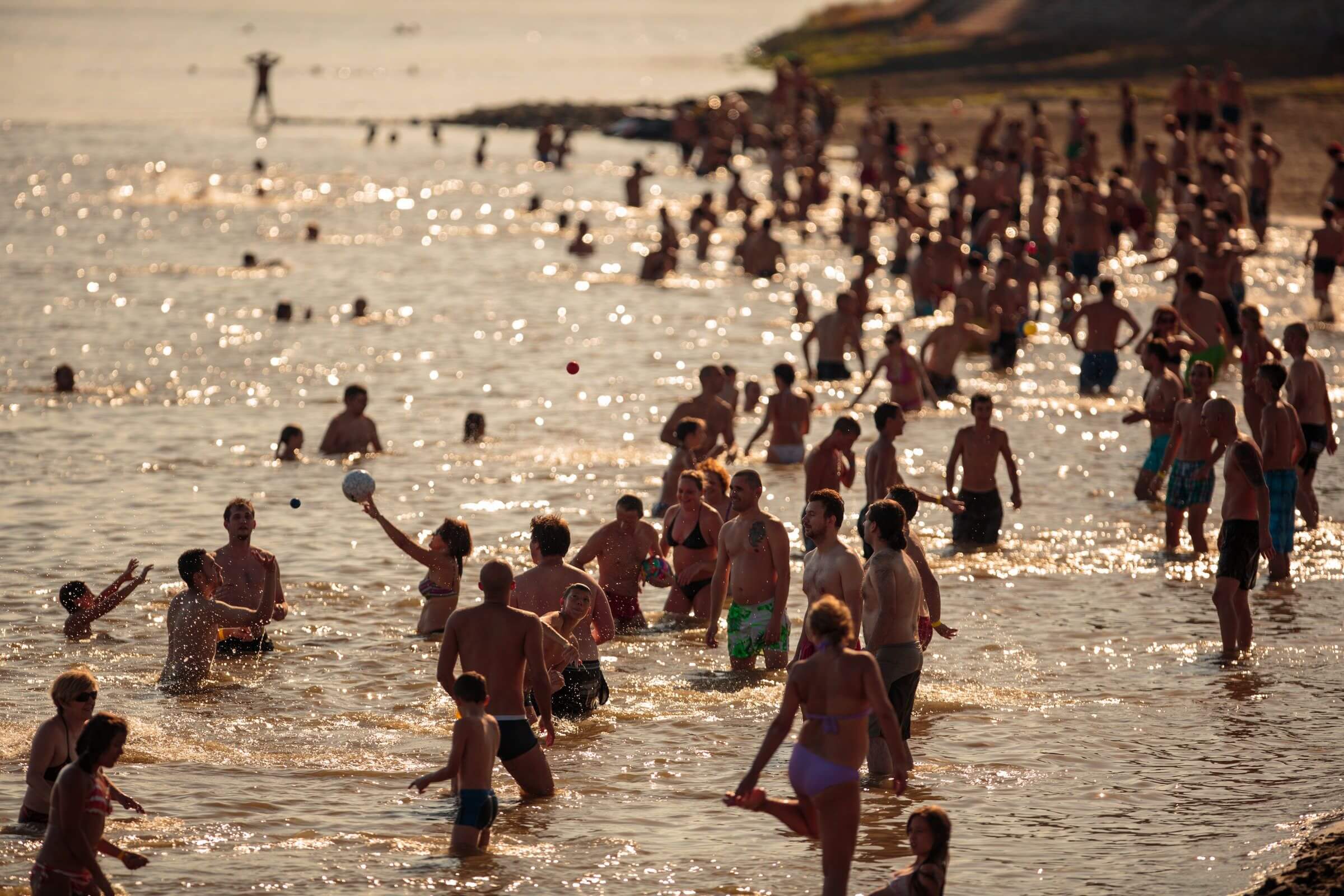
Famous Kopika (photo credit: Mario Romulić)
8.00 p.m. - onwards
After refreshments, it’s time to explore the nightlife in Osijek. This section is for both days in one since options are plentiful and, in most cases, you won’t make a mistake. However, these are the most famous ones that can make any list in Croatia. Definitely visit Radić Street which is teeming with pubs of all kinds and some of them are named after famous European cities - Barcelona and Amsterdam. In the recent past, there were New York and London but unfortunately, they haven’t survived. Even with those two gone, Barcelona and Amsterdam are still the ultimate picks if you want to see where the urban youth of Osijek and other parts of Slavonia love to go. Also, pub quizzes are amazing.
For drink/cocktail connoisseurs we recommend The Craft Room. The Craft Room bar is located right in the center of the town of Osijek. This concept bar is unique in this region because they offer a wide range of Gin and Whiskey from all over the world. Creative cocktails with innovative ingredients and award-winning bartender Miroslav Kljajić make this bar an unavoidable place to visit.
Beer lovers, do not fret! Gajba, a pub and tasting room, has every beer you want. From pale ales, lagers and so many other homegrown and worldly types of beers, this place is heaven for people who want to explore beer culture, not just of Osijek, but any European brew. If you want to visit soon, come just in time for the Craft Beer Festival that’s organized by, you guessed it, Gajba Pub.
If you think that’s all, it isn’t. Real nightlife is located in Tvrđa, where multiple nightclubs like Memories, Q Club, and more attract youth from Osijek and beyond. Foreign and domestic music “strikes” in all directions but one is an odd one out. If you want to hear Croatian live music tamburitza, go to Fort Pub - the Slavonian atmosphere and excited people make this place even better.
The end of the 48 hours of Osijek is almost done but not before leaving you visit Gold by Waldinger and Slatka Tvornica for some Slavonian sweetness - krempita, cakes, traditional Slavonian sweets, and a cup of coffee with travarica on the side? You can't go wrong.
We will end it here. This is our 48 hours in Osijek and hopefully, this guide will encourage you to come to visit Osijek, the heart of Slavonia. We deliberately left out nature park Kopački rit and the Baranja region because we wanted to emphasize how the city itself has so many things to offer. Still, that doesn't mean you shouldn't visit Baranja and the nature park because, at the end of the day, everything's connected. When talking about Osijek or Slavonia, people always say that the city or the region is underrated. I truly think it's not. What makes this area so beautiful and attractive to visitors is that people are not burdened by unrealistic expectations: we will never have tourist offers like Dubrovnik, Dalmatia, and Istria or the beautiful Adriatic Sea. We know our worth and that's why most of the time tourist goes home with a smile on their face. Charm, humility, and accepting people with open arms are our best tools. That's why Osijek is not underrated - it's properly rated.
Interested in bike tours of Slavonia? Check this article.
For more on travel in Croatia, follow TCN's dedicated page.
Split in 24 Hours: Attractions, Nature, Food, and Nightlife
April 30, 2022 – A look at the attractions, nature, food, and nightlife you must experience in Split in 24 hours.
Split is the second-largest city in Croatia and the largest city in the Dalmatia region and the Croatian Adriatic coast. Split has for many years been a transition hub, and fairly neglected by tourists. Nevertheless, in the last decade or so, Split has acquired quite a reputation and is becoming one of the most popular cities in Croatia. Split is most famous for Diocletian's Palace which was built by a Roman Emperor Diocletian in 305 AD and is located in the heart of the city. Split is also very famous for its rich culture, music festivals, football club Hajduk, beautiful beaches, Marjan hill, and many other attractions. If your goal is to experience the beautiful Adriatic coast while also enjoying the vivid urban life and exploring rich history in combination with local cuisine and the Dalmatian way of life, Split is your place to go.
9.00 a.m. – 10.00 a.m.
The start of the day in Split, the capital of Dalmatia, always has to begin with a coffee. I suggest visiting some of the numerous cafes in the Split city center or along the Riva. Also, it is good to grab something to eat while you are on the way. If you are a bakery person, head to Bobis, Prerada, Krušćić, and Tradicija (locals call it Kirigin) with the latter specializing in sweet pastries. Another good tip would be to visit the local green market which is also located in the city center, next to Diocletian's Palace. There you can find various stands with fresh fruits, vegetables, and other organic and homemade products. If you are keener on eating breakfast in a restaurant, Brasserie on 7 or Zinfandel should be on your list.
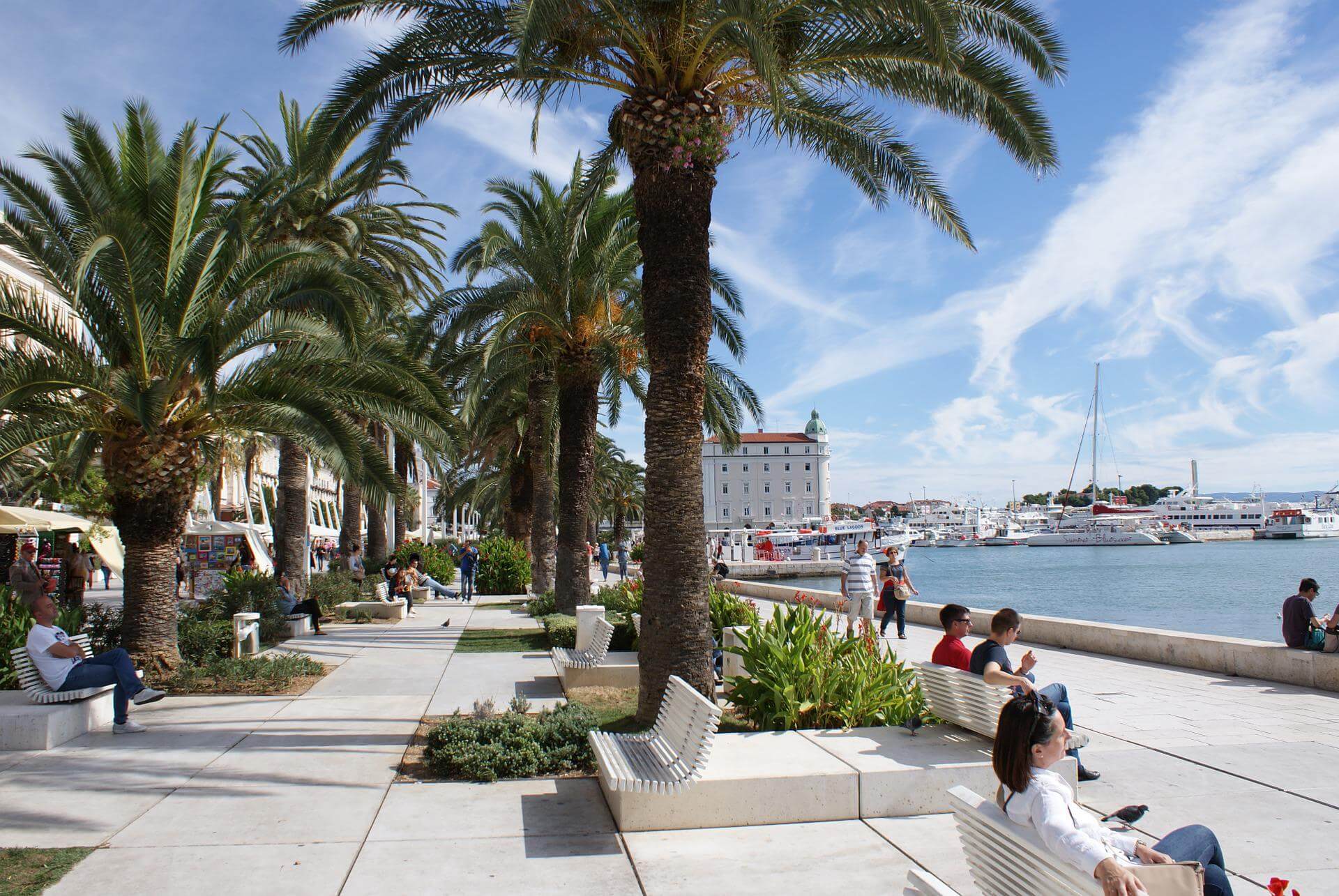
Split Riva ; source: Pixabay
10.00 a.m. – 13.00 a.m.
After eating a proper breakfast and drinking your morning coffee, I would recommend wandering around the city center and especially Diocletian's Palace. There you have many city attractions such as the Saint Duje bell tower, Split city museum, Diocletian's cellars, Split Ethnographic museum, Temple of Jupiter, and of course the main city square Peristil and neighboring Vestibul.
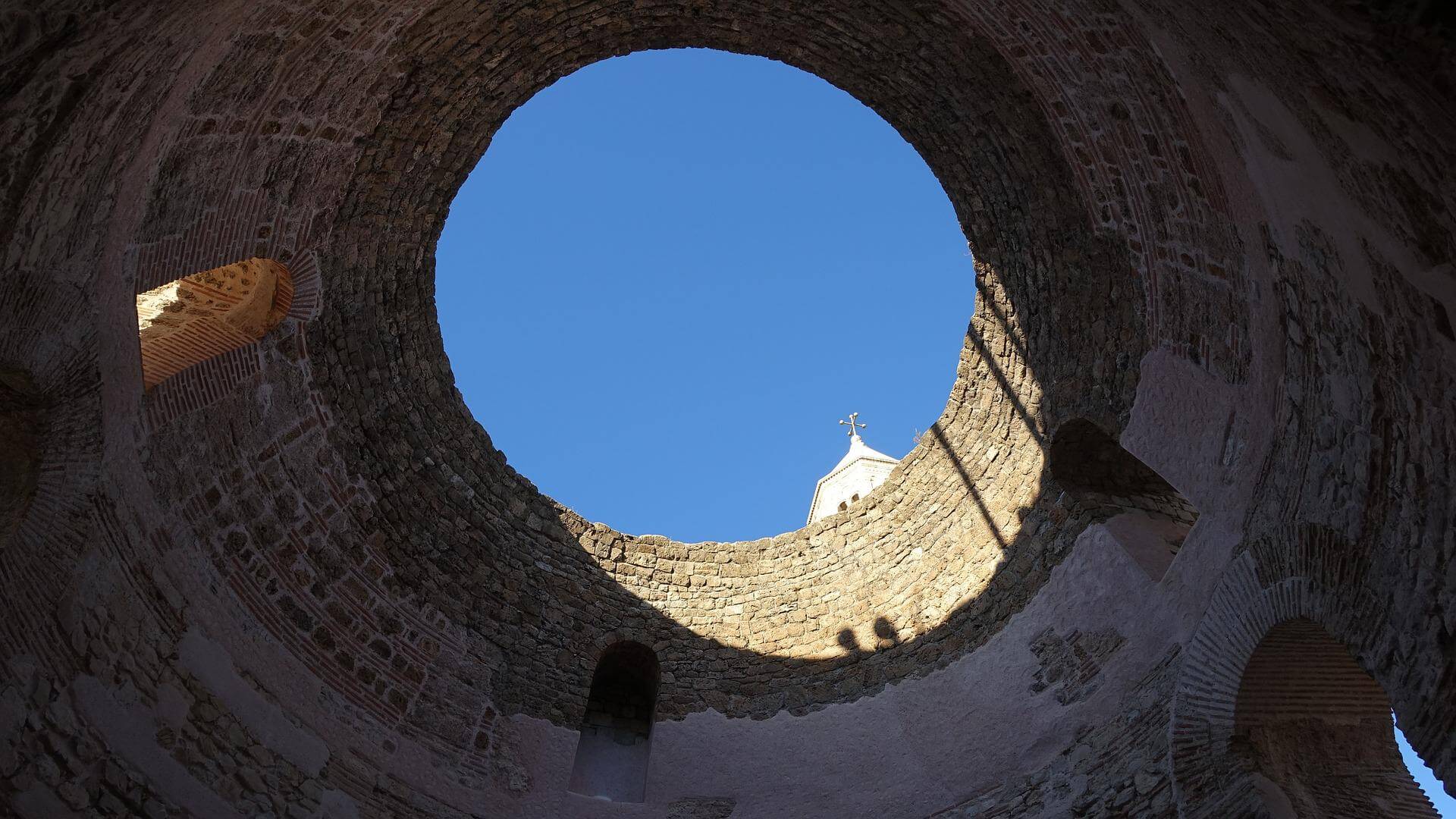
Vestibul ; source: Pixabay
Since it is not possible to visit all of the aforementioned city attractions, I will leave the choice up to you. Nevertheless, I would strongly recommend climbing up the St. Duje bell tower or at least the Vestibul (you can access it through the ethnographic museum) just to get a sense of the city and the surrounding islands.
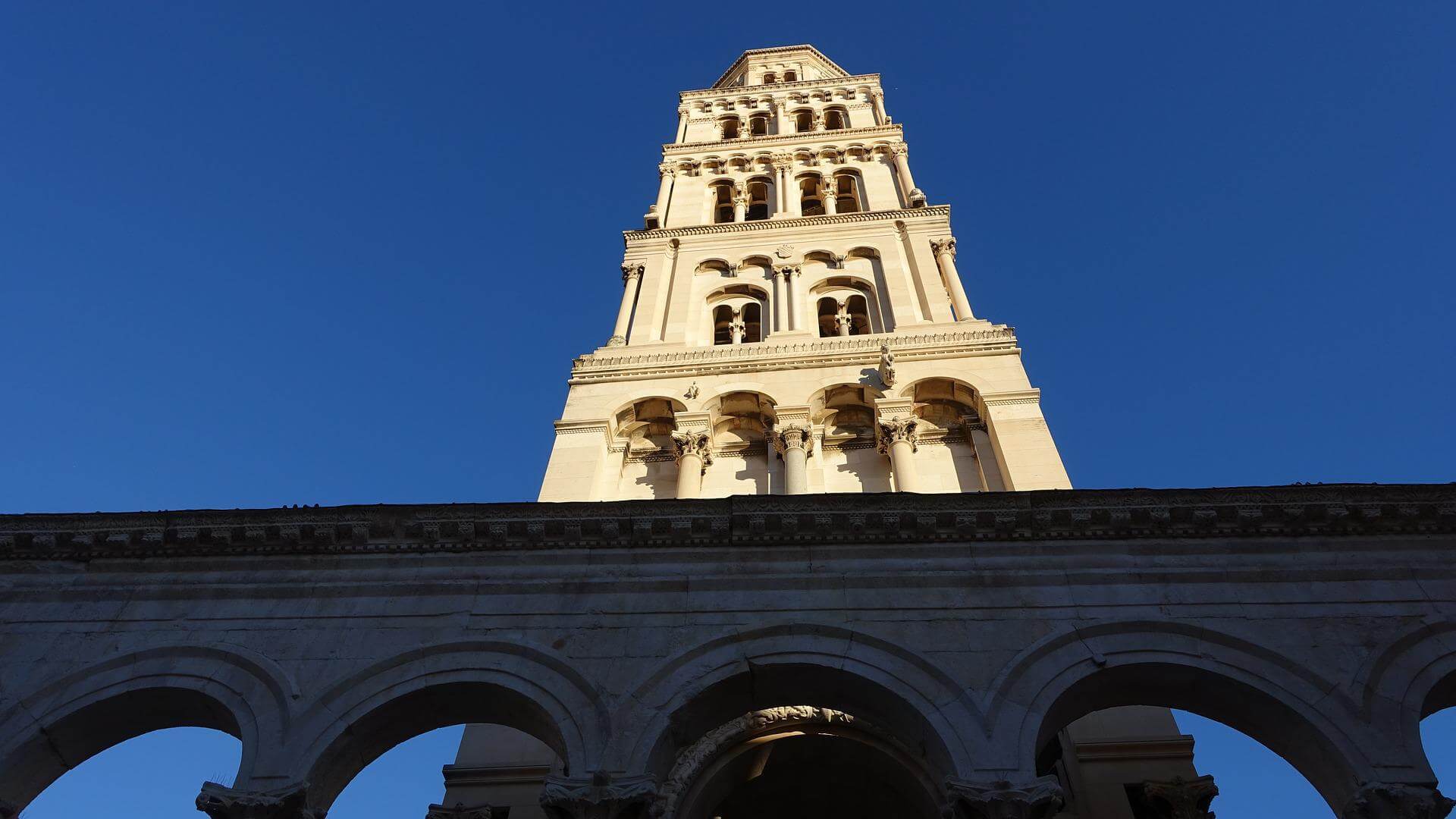
Saint Duje bell tower; source: Pixabay
10.00 a.m. – 13.00 p.m.
It is already lunchtime so it is time to try some of the well-praised local cuisine. There are numerous Dalmatian dishes that you should try, such as Dalmatian prosciutto and cheese, Pašticada, Gregada, Škampi na Buzaru, Peka (veal, octopus, or lamb), Fritule, Rožata, Soparnik, Viška pogača, Crni rižot (Squid Ink risotto) and many many more. Some of the well-praised local restaurants are the following: Konoba Varoš, Konoba Hvaranin, Šug, Zrno Soli, Adriatic, Uje, and Chops Grill, among many others. If you are traveling on a budget or you would just like to experience the street food of split, then check out this list.
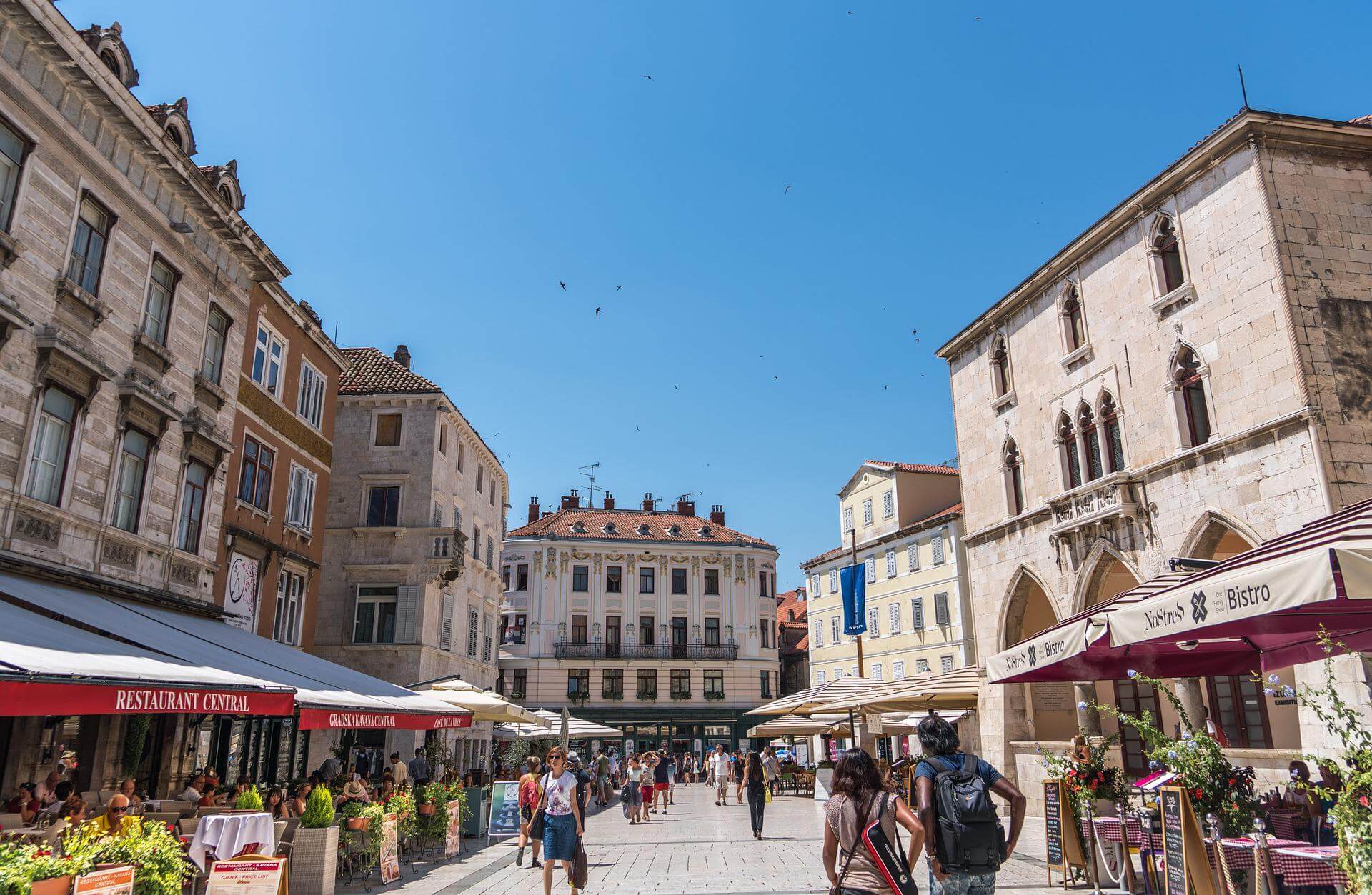
Pjaca; source: Pixabay
4.00 p.m. – 6.00 p.m.
After eating, it is a perfect time for an after-lunch stroll up the Marjan hill. You can access it through the Marjan stairs that lead you to Vidilica and from there to the St. Nicholas church. From there you can either continue further or if you are in the right mood you can climb up to the peak (takes around 30 minutes).
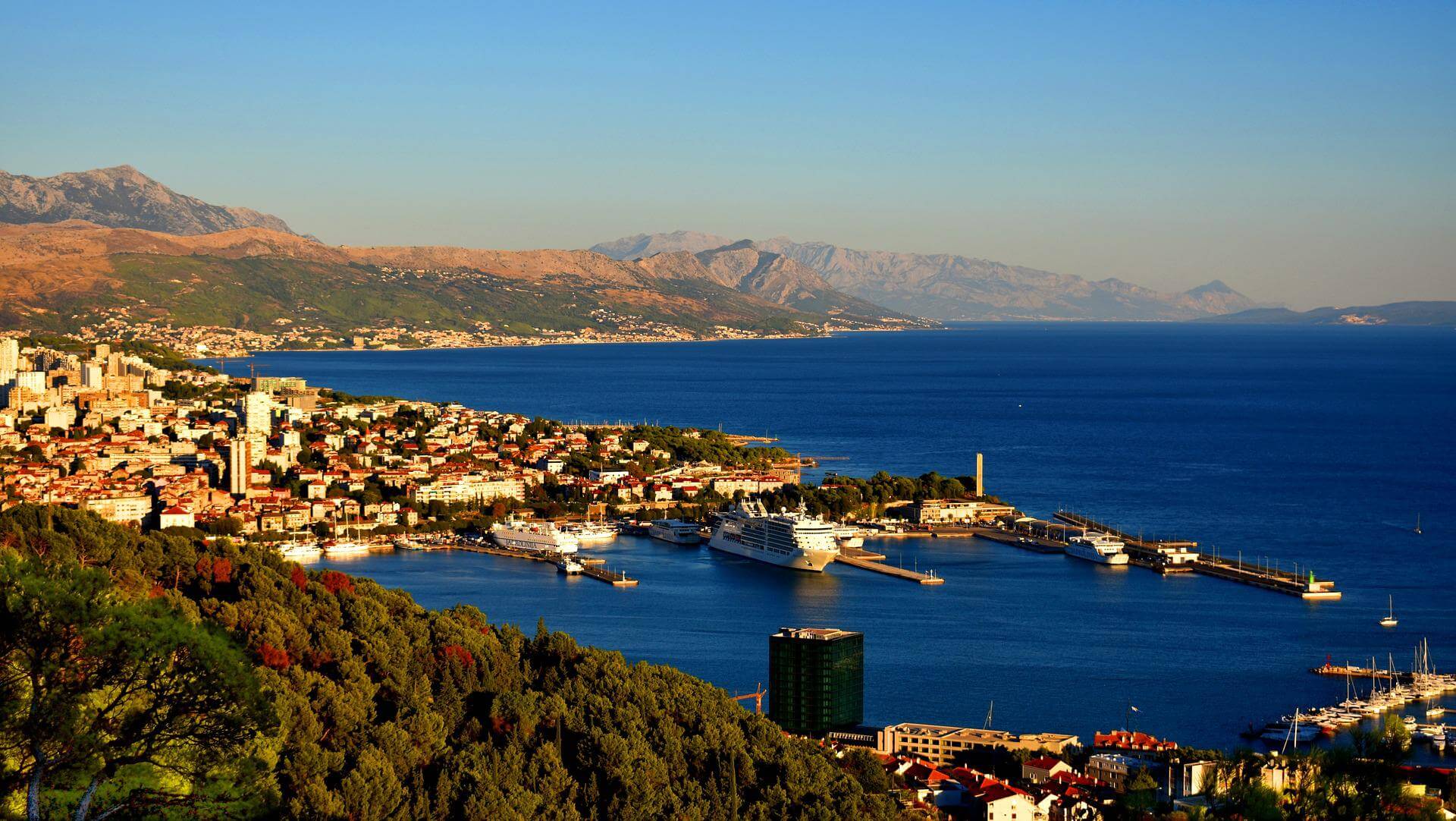
View from the Marjan Hill; source: Pixabay
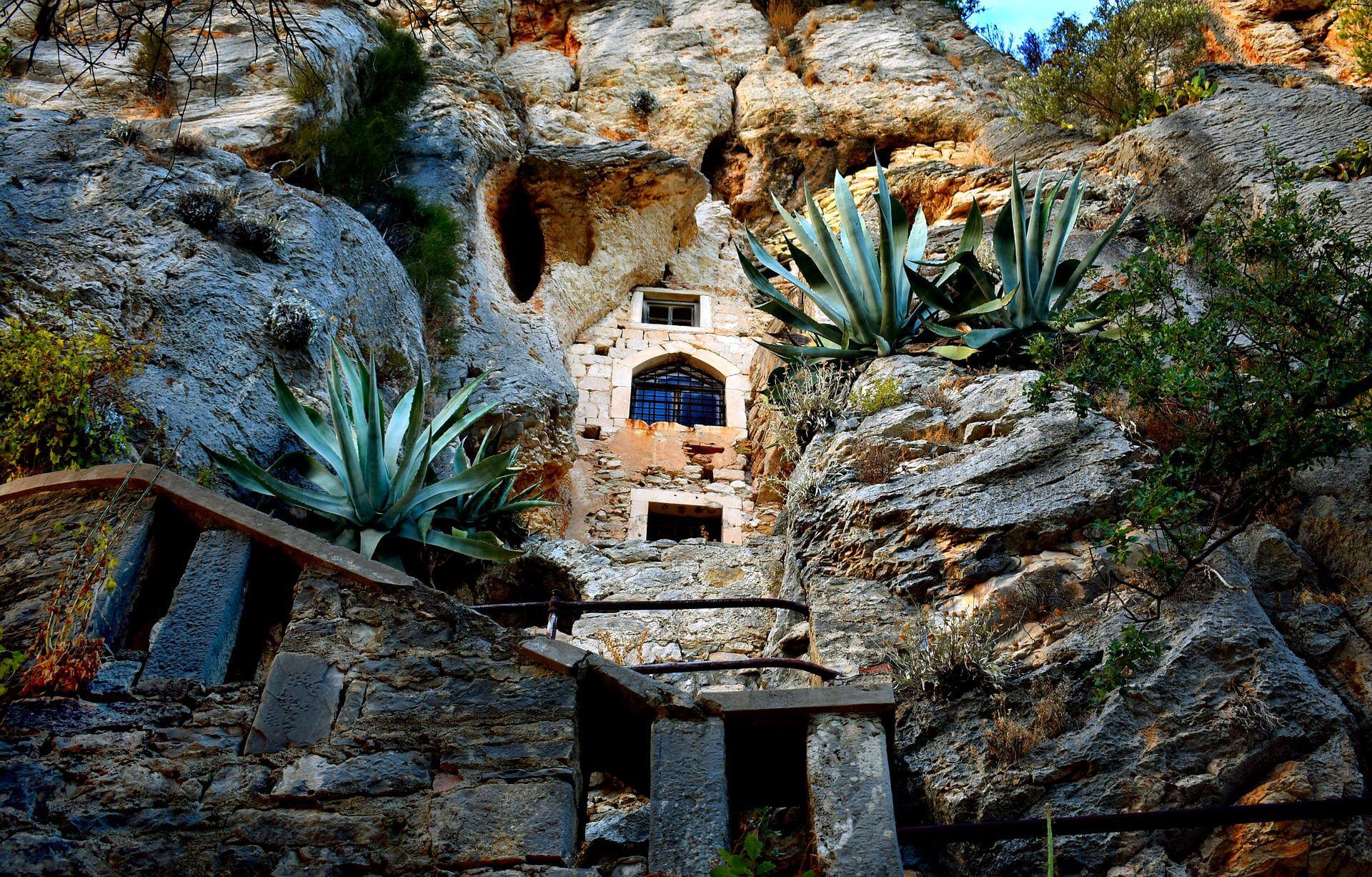
hermitage of St. Cirijaka on Marjan; source: Pixabay
Besides the already mentioned Split city museum and the ethnographic museum which are in the city center, there are three other museums I would strongly suggest visiting. The first one is located close to the Marjan hill and it is the Museum of archaeological monuments. The second one is the Split archaeological museum located near the magnificent Poljud city stadium (home ground of Hajduk Split). Lastly, the third one is the Croatian Maritime Museum, located in the Baroque fortress of Gripe which is also a great place to visit (a 10-minute walk from the city center).
If you are visiting Split in the summertime, you should check out the beaches around the Marjan hill since these are the least crowdy and nature there is simply stunning. If you are into sports, you should head down to Bačvice or Firule beach where you will find locals playing a local game of picigin.
6.00 p.m. – 9:00 p.m.
It is time to head back to the city center, on your way you can visit Sustipan and Zvončac which are two small parks. From there you can walk along the Zapadna Obala (West Coast) towards the center. It is again time to experience local dishes preferably seafood accompanied by world praised Dalmatian wines. Split thrives in the evening and you can feel its energy on every corner, especially in the summer.

View from the Sustipan peninsula; source: Pixabay
There is always something happening in the city, bars such as Basket, Adriatic Social Club, Ghetto, Flag Pub, and Charlie's are known for live performances and good music. On the other hand, there is Hrvatski Dom which offers a wide variety of classical music events. Split has a deep connection with music, and if you don't know who Dino Dvornik or Oliver Dragojević are then please find out as quickly as possible. Needless to say that it is not a coincidence that Split is home to many music festivals such as Ultra Europe, Split Summer Festival, Split Festival, Split Blues Festival, Fibra Festival, Ego Free Festival, and Xstatic. There are also two important film festivals taking place in Split, Mediterranean Film Festival (June) and Split Film Festival (September).
9.00 p.m. – onwards
If you are still looking for action, then I suggest either staying in the city center where you can visit numerous bars and pubs and even end up in a club such as Kuka, Central or 305 AD. If you want to extend the nightlife even further and you don't mind getting out of the center then you have two unique possibilities either going to the "Barbarinac Island of love" known in the slang as Barbados or hopping off to some boat party. These two venues happen only through summer and usually over the weekend.
That would be all for Split in 24 hours, to be honest, you should multiply these hours by at least 5 since this is undoubtedly one of the pearls on the Adriatic coast as well as in the Mediterranean.
If you want to find out more about Split, check out our dedicated section Split in a page 2022.
For more on travel in Croatia, follow TCN's dedicated page.
Croatia's Industrial Production Down For the First Time in 15 Months
ZAGREB, 29 April (2022) - Croatia's industrial production fell in March 2022 for the first time in 15 months, indicating a slowing of the economic recovery.
Industrial production decreased by 2.6% from February 2022 and by 1.9% from March 2021, the Croatian Bureau of Statistics (DZS) said on Friday.
Annual decreases were observed in four of five sectors, with production of capital goods decreasing the most, by 6.7%.
Production of energy fell by 4.0%, of non-durable consumer goods by 3.3% and of durable consumer goods by 2.3%, while production of intermediate goods increased by 2.3%.
In the first quarter of this year, industrial production rose by 1.7% year on year.
Production and economic growth might slow down this year because of the economic impact of Russia's military invasion of Ukraine.
"According to our expectations, the modest positive growth rate for this year, considering geopolitical developments, is exposed to negative risks. The recovery of external demand will be more modest given the potentially unfavourable impact of current geopolitical conflicts and the dependence of some of Croatia's most important trading partners on Russia. On the other hand, the low base effect will have a positive impact," analysts at Raiffeisenbank Austria (RBA) said in their comment on the DZS report.
For more, check out our business section.
Croatian National Bank: Corporate Loans Pick Up in March
ZAGREB, 29 April (2022) - Total lending by monetary institutions to domestic sectors, except the central government, increased by HRK 4 billion in March, with the annual growth rate accelerating from 4% to 5%, the Croatian National Bank (HNB) said on Friday.
This was the result of the increase in loans. Corporate loans increased by HRK 3.7 billion or 6.7% and household loans by HRK 900 million, while loans to other domestic sectors decreased by HRK 400 million.
In the structure of household loans, housing loans and general-purpose cash loans continued to increase, both by HRK 300 million.
The annual growth rates of both housing and general-purpose loans remained at previous month’s level, at 8.0% and 3.4% respectively, so household loans accelerated only slightly, from 4.4% in February to 4.5% in March. On the other hand, corporate loans accelerated considerably, from 2.4% in February to 6.7% in March.
For more, check out our business section.
Valamar Riviera Sees Strong Increase in Q1 Revenues, Overnights
ZAGREB, 29 April (2022) - The Valamar Riviera hotel company generated HRK 59.5 million in operating revenues in Q1 2022, up 97% year-on-year, with an increase of 147,000 in overnight stays, or 192%, the company said in a financial statement on Friday, announcing a return to the occupancy rate from 2019 this year.
Total revenues reached HRK 74.8 million, up 119% on the year.
"In Q1 2022, Valamar Riviera achieved results comparable to 2019, continuing the positive trend of tourism recovering to the pre-pandemic level," Croatia's largest tourist company said.
In that period, total expenditures reached nearly HRK 314 million, so the group ended Q1 with a loss of HRK 199.85 million.
Investments for the 2022 season in hotels, summer resorts and camps amount to about HRK 530 million and are an important driver of growth and positive expectations, the company said.
Among the largest investment projects is the investment by Imperial Riviera of HRK 67 million in the repositioning of the Dalmacija hotel in Makarska, whose opening is planned for mid-May.
The investments of Helios Faros are worth HRK 220 million and are related to the construction of the Valamar Amicor Green Resort and Aquamar pool complex on the island of Hvar.
Other investments for this season include the renovation of the hotel Corinthia in Baška on the island of Krk in the Valamar brand Sunny Plus, improving service quality at the Valamar Bellevue Hotel in Rabac, the construction of Padova beach on the island of Rab, and the continuation of investments in the camps Istra Premium Camping Resort and Lanterna Premium Camping Resort.
In Dubrovnik, a new Valamar House has opened for the accommodation of seasonal workers, the fifth in Valamar destinations.
"The results achieved in the first quarter and booking trends are encouraging and announce a high demand for Croatia in this tourist season and a return to the levels of occupancy from 2019. Due to a significant rise in energy, labour and procurement prices, there is a risk of inflation, which contributes to uncertainty and difficult business conditions, especially jeopardising the future development and investments that Croatian tourism really needs," said Željko Kukurin, President of the Management Board of Valamar Riviera.
(€1 = HRK 7.5)
For more, check out our business section.


